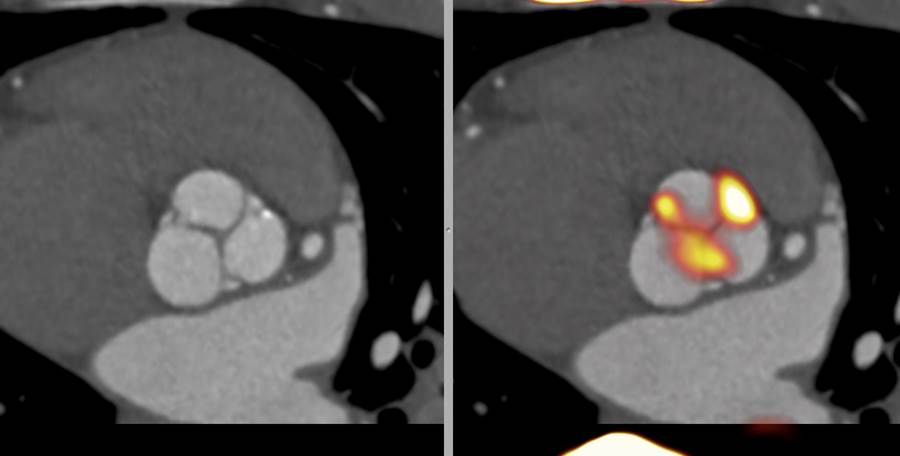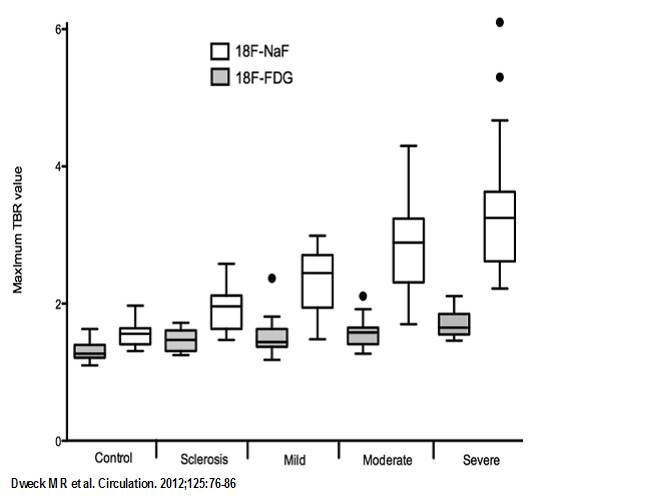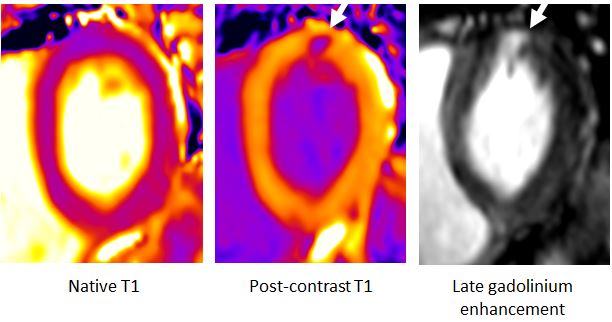Utility of PET and MRI in AS
Aortic stenosis (AS) is characterised both by progressive narrowing of the aortic valve and by how the ventricle adapts and ultimately decompensates in the face of the increased pressures placed upon it.1 Modern noninvasive imaging can provide complementary information to that provided by standard echocardiographic techniques with respect to both processes. In particular, positron emission tomography (PET) can inform about disease activity in the valve leaflets, and cardiovascular magnetic resonance (CMR) can inform about the hypertrophic response of the left ventricle (LV) and in particular the development of myocardial fibrosis as patients transition toward heart failure.
The Valve: PET
PET is a powerful imaging modality that can inform about the activity of specific disease processes as they occur in the body. In particular, two tracers with proven safety records in oncology imaging have been used to investigate AS. The inflammation tracer 18F-fluorodeoxyglucose (18F-FDG) is a glucose analogue that labels cells with high metabolic requirements, including vascular macrophages.2 18F-fluoride is a bone tracer, which passively binds to hydroxyapatite crystals to form fluoroapatite. It has been shown to preferentially bind to regions of newly developing microcalcification (beyond the resolution of computed tomography [CT]), which have a higher surface area than established macroscopic deposits (Figure 1).3
Figure 1
In an attempt to better define the relative contribution of inflammation and calcification, patients with varying degrees of AS (including controls and those with aortic sclerosis) underwent sequential PET imaging with both 18F-FDG and 18F-fluoride.4 Similar to previous studies,5 18F-FDG activity was increased in patients with AS compared with controls (1.58 ± 0.21 vs. 1.30 ± 0.13; p < 0.001) with a modest but significant correlation with disease severity (r2 = 0.47, p < 0.001). When the same cohort was imaged with 18F-fluoride, uptake was again increased in patients with AS compared w healthy controls (2.87 ± 0.82 vs. 1.55 ± 0.17, p < 0.001); however, the observed PET signal was stronger and more clearly demarcated. A stronger correlation with disease severity as measured by peak velocity was also observed (r2 = 0.53, p < 0.001). The highest 18F-fluoride activity was observed in those with the most advanced disease (Figure 2). Although 18F-fluoride uptake was 28% higher in the valve than in regions of co-existent aorta atheroma (target-to-background ratio: 2.66 ± 0.84 vs. 2.11 ± 0.31, respectively, p < 0.001), the reverse was true for 18F-FDG (target-to-background ratio: AS 1.56 ± 0.21 vs. atheroma 1.81 ± 0.24, respectively, p < 0.001), highlighting the important pathological differences between AS and atherosclerosis.6
Figure 2
Importantly, 18F-fluoride PET predicts disease progression in AS. When patients returned for repeat CT calcium scoring of the valve at 1 and 2 years, a close correlation was observed between the baseline valvular 18F-fluoride uptake and the progression of the aortic valve CT calcium score (r = 0.80 [0.69-0.87]; p < 0.001).7,8 Moreover, 18F-fluoride predicted adverse clinical outcomes independent of age and gender.8 CT calcium scoring is a cheaper and more widely available technique that offers similar prediction of disease progression and adverse events in AS, although the PET technique does appear to provide information of some incremental value.8
18F-fluoride PET, therefore, acts as a marker of calcification activity in AS. Its clinical role may be limited by expense and availability, but this technique is rapidly evolving. If refined protocols can demonstrate a clear benefit in identifying patients who will progress quickly toward aortic valve replacement, then the technique may have a clinical future in risk stratifying patients. More immediately, 18F-fluoride PET is being explored as a surrogate end point in clinical trials examining the effects of novel drugs on disease activity in AS (e.g., SALTIRE II [Study Investigating the Effect of Drugs Used to Treat Osteoporosis on the Progression of Calcific Aortic Stenosis; NCT02132026]). Based on the principle that 18F-fluoride PET acts as a marker of activity, it is hoped that treatment effects will be detectable more rapidly than using CT or echocardiography, shortening the duration of phase 2 clinical trials and reducing their expense.
Finally, other studies are examining whether 18F-fluoride imaging can be performed at low radiation dose using PET or CMR and whether it can detect early signs of calcification in bioprosthetic valves as an early marker of valve degeneration. The latter could provide valuable insights into the longevity of next-generation valves and identify patients at risk of rapid valve failure.
The Myocardium: CMR
Pathological studies have demonstrated that progressive myocardial fibrosis is one of the key drivers of LV decompensation in AS and the transition from hypertrophy to heart failure.9 CMR is able to visualize and quantify myocardial fibrosis directly using two techniques (Figure 3). The first is late gadolinium enhancement (LGE), which detects regions of replacement fibrosis in a mid-wall pattern that is easily differentiated from previous myocardial infarction. Importantly, this type of fibrosis appears to be irreversible following aortic valve replacement10 and is associated with multiple other markers of LV decompensation.11,12 Moreover, there is now evidence from three separate cohorts that the presence of replacement fibrosis is a strong independent risk factor for adverse outcomes.13-15 Mid-wall LGE, therefore, appears to be an objective marker of LV decompensation in AS. A multicentre, randomized controlled trial is due to begin enrollment next year, testing whether early valve intervention in asymptomatic patients based on the presence of mid-wall replacement fibrosis improves clinical outcomes. If positive, these would be the first randomized controlled trial data to assess the optimal timing of surgery in a sub-group of asymptomatic patients with AS and a marker of clinical risk.
Figure 3
In fact, the most common form of fibrosis in AS is interstitial fibrosis, a diffuse and potentially reversible form of fibrosis that is missed by the LGE approach. There is, therefore, considerable interest in novel T1 mapping approaches that can detect diffuse fibrosis,16,17 although at present this approach is limited by overlap between control and disease states and variability in T1 mapping values between different scanners and vendors.18
Conclusion
Modern noninvasive imaging techniques can provide complementary information in AS to standard echocardiographic assessments. In particular PET imaging can inform about disease activity in the valve and CMR about decompensation of the hypertrophic LV response. Studies are ongoing to assess whether this information is clinically useful.
References
- Dweck MR, Boon NA, Newby DE. Calcific aortic stenosis: a disease of the valve and the myocardium. J Am Coll Cardiol 2012;60:1854-63.
- Rudd JH, Narula J, Strauss HW, et al. Imaging atherosclerotic plaque inflammation by fluorodeoxyglucose with positron emission tomography: ready for prime time? J Am Coll Cardiol 2010;55:2527-35.
- Irkle A, Vesey AT, Lewis DY, et al. Identifying active vascular microcalcification by (18)F-sodium fluoride positron emission tomography. Nat Commun 2015;6:7495.
- Dweck MR, Jones C, Joshi NV, et al. Assessment of valvular calcification and inflammation by positron emission tomography in patients with aortic stenosis. Circulation 2012;125:76-86.
- Marincheva-Savcheva G, Subramanian S, Qadir S, et al. Imaging of the aortic valve using fluorodeoxyglucose positron emission tomography increased valvular fluorodeoxyglucose uptake in aortic stenosis. J Am Coll Cardiol 2011;57:2507-15.
- Dweck MR, Khaw HJ, Sng GKZ, et al. Aortic stenosis, atherosclerosis, and skeletal bone: is there a common link with calcification and inflammation? Eur Heart J 2013;34:1567-74.
- Dweck MR, Jenkins WS, Vesey AT, et al. 18F-sodium fluoride uptake is a marker of active calcification and disease progression in patients with aortic stenosis. Circ Cardiovasc Imaging 2014;7:371-8.
- Jenkins WS, Vesey AT, Shah AS, et al. Valvular (18)F-Fluoride and (18)F-Fluorodeoxyglucose Uptake Predict Disease Progression and Clinical Outcome in Patients With Aortic Stenosis. J Am Coll Cardiol 2015;66:1200-1.
- Hein S, Arnon E, Kostin S, et al. Progression from compensated hypertrophy to failure in the pressure-overloaded human heart: structural deterioration and compensatory mechanisms. Circulation 2003;107:984-91.
- Weidemann F, Herrmann S, Störk S, et al. Impact of myocardial fibrosis in patients with symptomatic severe aortic stenosis. Circulation 2009;120:577-84.
- Chin CW, Shah AS, McAllister DA, et al. High-sensitivity troponin I concentrations are a marker of an advanced hypertrophic response and adverse outcomes in patients with aortic stenosis. Eur Heart J 2014;35:2312-21.
- Shah AS, Chin CW, Vassiliou V, et al. Left ventricular hypertrophy with strain and aortic stenosis. Circulation 2014;130:1607-16.
- Azevedo CF, Nigri M, Higuchi ML, et al. Prognostic significance of myocardial fibrosis quantification by histopathology and magnetic resonance imaging in patients with severe aortic valve disease. J Am Coll Cardiol 2010;56:278-87.
- Dweck MR, Joshi S, Murigu T, et al. Midwall fibrosis is an independent predictor of mortality in patients with aortic stenosis. J Am Coll Cardiol 2011;58:1271-9.
- Barone-Rochette G, Piérard S, De Meester de Ravenstein C, et al. Prognostic significance of LGE by CMR in aortic stenosis patients undergoing valve replacement. J Am Coll Cardiol 2014;64:144-54.
- Flett AS, Hayward MP, Ashworth MT, et al. Equilibrium contrast cardiovascular magnetic resonance for the measurement of diffuse myocardial fibrosis: preliminary validation in humans. Circulation 2010;122:138-44.
- Chin CW, Semple S, Malley T, et al. Optimization and comparison of myocardial T1 techniques at 3T in patients with aortic stenosis. Eur Heart J Cardiovasc Imaging 2014;15:556-65.
- Everett RJ, Stirrat CG, Semple SI, Newby DE, Dweck MR, Mirsadraee S. Assessment of myocardial fibrosis with T1 mapping MRI. Clin Radiol 2016;71:768-78.
Keywords: Aorta, Aortic Valve, Aortic Valve Stenosis, Apatites, Atherosclerosis, Biomarkers, Calcinosis, Disease Progression, Echocardiography, Fluorides, Fluorodeoxyglucose F18, Gadolinium, Glucose, Heart Defects, Congenital, Heart Failure, Heart Valve Diseases, Heart Ventricles, Hydroxyapatites, Hypertrophy, Inflammation, Macrophages, Magnetic Resonance Spectroscopy, Myocardial Infarction, Myocardium, Osteoporosis, Phosphates, Plaque, Atherosclerotic, Positron-Emission Tomography, Risk Factors, Sclerosis, Tomography, X-Ray Computed
< Back to Listings



